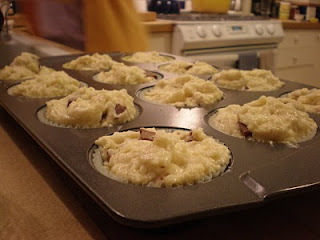 Dani, I apologize in advance for this post which is not really sharing a recipe or specific culinary-venture. Instead I am going to waste your time contemplating some food related concepts, with the occasional pseudo-recipe interspersed, and the more frequent revelation of my inability to properly use my alleged brain.
Dani, I apologize in advance for this post which is not really sharing a recipe or specific culinary-venture. Instead I am going to waste your time contemplating some food related concepts, with the occasional pseudo-recipe interspersed, and the more frequent revelation of my inability to properly use my alleged brain.#1: Butterscotch. What's up with that. I recently purchased a bag of butterscotch chips for a butterscotch brownie recipe. In true me form, I opened the bag before I intended to actually bake with the chips. I wanted to use a few in a fake sundae I was making myself with yogurt and chocolate chips. Butterscotch seemed the cherry on top to eliminate all possible health-redemption from the yogurt. Suggestion: don't try this if you don't want to be fat. I found myself returning to the cupboard every few bites to add a few more butterscotches to the mixture. In the end, I thoroughly enjoyed my butterscotch-chips-with-yogurt. I'm sure the regret will set in when I find I am 1 cup short on the butterscotch for the brownies and 10 pounds heavier. Until then, I will be snacking on butterscotch/choc chip trail mix (yes, I just invented this. No, there are no other ingredients).

#2: Beans. Yum. Always. With Dani off in Portland, I found myself longing to hear her attempting to lure me to her house with the promise of beans (this always works when I am hungry). Her mom, a kitchen boss, makes the most delicious beans in the ever-intimidating pressure cooker. I, very obligingly, consume the beans at any and every opportunity. They are delicious with cheese, tortillas, avocados, mushrooms, chicken?, really any sauteed vegetable, or just plain. As luck would have it, Nic had left an unopened can of black beans at my house (cheers). Being that I do not have a pressure cooker or beans skills, canned is my only feasible option for creating something edible involving beans. I set to work improvising. I cooked some garlic and threw in a random pepper that miraculously happened to be in my house. I let these items sizzle for some time (and burn just a little..) before I poured in the beans, and about 3/4 tsp ground cumin. Upon tasting the beans, I decided to add some chipotle flakes and chili flakes. A good decision. As I have no comal, I stove top heated some tortillas and devoured. It could have been worse.

#3: Hummus: A tragedy. Well, if we're being honest, the real tragedy is my absolute idiocy in certain contexts. I realize that I take a chance whenever I diverge from the recipes I follow in baking projects; baking is a science blah blah blah. This is a risk I am willing to take in the interest of saving time and resources and maybe, just maybe, coming out with a win (baseball season metaphor). The point being, most of my foodie failures stem from an adventurous laziness, rather than from pure stupidity. My most recent attempt at hummus does not fall into this category of failures.
I had made Molly Katzen's hummus a few weeks ago, much to my delight, and decided to repeat it. I dumped 1 can chickpeas, 3 tbsp tahini, 2 tbsp lemon juice, a clove of garlic and 1 tsp cumin into my shiny new food processor, secured the top (with far fewer hiccups than my last attempt to use Cuizzee (rhymes with weezy), and pressed "pulse." Nothing. I removed the lid, re-attached it, pressed pulse. Nothing. I removed the bowl, re-attached it, pressed pulse. Nothing. I un-plugged the machine, removed the lid and the bowl, re-attached the bowl and secured the lid, plugged in the base and pressed pulse. Nothing. It was not until the genius Camila took a crack at assembling the machine a week later that I realized (although I did not admit this at the time) that I had been putting the bowl on backwards (it seemed to click into place at the time, leading me to assume that the cuisinart was defective, and not I). Woops. After multiple frustrated attempts, I eventually scraped the contents into the itsy-bitsy and highly temperamental cuinsinart we have. Lil Cuizzee made a valiant effort to chop all these ingredients into a smooth, cohesive dip-spread, but it just couldn't take the pressure. The end result was a very chunky, lemony substance, with the occasional large bite of garlic. It wasn't bad, but it wasn't hummus. Perhaps something got lost in transferal of the ingredients from vessel to vessel. Perhaps Cuizzee hates me (see future post about cuisinart bread attempt 2). Either way, after I write this, I will be throwing the remains of the non-hummus to the worms.

































